A reblog of nerdy and quirky stuff that pique my interest.
291 posts
Latest Posts by philosophical-amoeba - Page 2



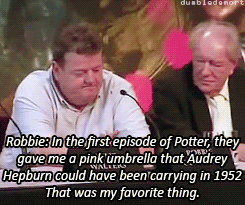




What was your favorite prop or costume from the “Harry Potter” films?


Plantigrade vs. Digitigrade Carnivores - the Polar Bear and the African Lion
The foot structure of many animals plays a critical role in their locomotion and environmental niche, and in carnivores, the clear distinction between plantigrade (walking with the podials and metatarsals both flat on the ground) and digitigrade (walking on the toes, with the heel and wrist permanently raised) animals is most evident.
In plantigrade beasts - which include humans, many rodents, bears, racoons, and opossums - the larger surface area that the many bones provide can act as both a stabilizer and a very effective bearer of great weights. In fact, the big ol’ flighted dinosaurs were plantigrade. At the same time, so were the first (and relatively small) mammals, since both of them needed lots of stability in their feet. The weight-bearing ability and stable platform comes at the cost of speed, as the energy and requirements for movement of so many bones and muscles is much greater than digitigrade feet or unguligrade feet.
Digitigrade animals walk on only their toes, leaving their wrists and ankles permanently raised. This affords more speed, much more silent movement. Cats, birds, and dogs are digitigrade. Digitigrade feet evolved long after plantigrade feet, to fit the niche of mid-sized carnivores. However, they cannot effectively sustain large loads, which is why you cannot use a lion as a pack mule. Well, among other reasons. Really, you just don’t want to try using any mid-sized (or large, in the lion’s case) carnivore as a pack mule.
On the Anatomy of Vertebrates. Richard Owen, 1866.

Beautiful Blaschka glass model of a Glaucus sea slug.
These amazing animals can give a painful sting if handled. This is because they feed on colonial cnidarians such as Portuguese man o’ war and store the venomous nematocysts of their prey for self-protection.

Back when I was a studying biology, I noticed that a lot of anatomical terms sound like they come straight from Middle Earth. So, to celebrate the release of the last Hobbit film, I’ve created this INCREDIBLY nerdy quiz.
Do these words and phrases refer to parts of the human body, or reference people and places from J. R. R. Tolkien’s work?
Antrum of Highmore
Crypt of Morgagni
Caves of Androth
Lobelia
Loop of Henle
Scapha
Great Vein of Galen
Halls of Mandos
Groin
Gap of Calenardhon
Macewen’s Triangle
Canal of Schlemm
Gerontius
Islets of Langerhans
Meckel’s Cave
Chamber of Mazarbul
You shall not pass.

Rockfleet Castle, Co. Mayo, Ireland. It’s a former home of Grace O`Malley (Gráinne Mhaol), the famous 16th century ‘Pirate Queen’.
Photo: Mikeoem (CC-BY-SA-4.0 )
In a recent video, Practical Engineering tackles an important and often-overlooked challenge in civil engineering: dam failure. At its simplest, a levee or dam is a wall built to hold back water, and the higher that water is, the greater the pressure at its base. That pressure can drive water to seep between the grains of soil beneath the dam. As you can see in the demo below, seeping water can take a curving path through the soil beneath a dam in order to get to the other side. When too much water makes it into the soil, it pushes grains apart and makes them slip easily; this is known as liquefaction. As the name suggests, the sediment begins behaving like a fluid, quickly leading to a complete failure of the dam as its foundation flows away. With older infrastructure and increased flooding from extreme weather events, this is a serious problem facing many communities. (Video and image credit: Practical Engineering)


Rishi coffin for a commoner
Second Intermediate Period, Dynasty 17, 1580–1550 B.C. (find spot unknown)
In Dynasty 17 a new type of coffin appeared in Thebes: anthropoid, but no longer conceived solely as an inner coffin, and resting on its back because of a change in funerary customs whereby the deceased was no longer laid on one side. The anthropoid coffin was to become the burial container of choice among royals and commoners alike. The earliest examples are decorated in paint with a feather pattern, and so they are known by the Arabic word for “feathered,” rishi. Carved from local sycamore because the Thebans no longer had access to imported cedar, all rishi coffins, royal or private, show the deceased wearing the royal nemes headdress. This example was clearly a stock item made for a commoner, for a blank space was left for the owner’s name to be inserted at the end of the vertical inscription on the lid (a conventional offering formula for the dead).
Great vulture’s wings envelop the legs and lower abdomen. Even the top of the headdress is decorated with a feather pattern so that the deceased appears as a human-headed bird according to the concept of the ba, or mobile spirit. The ba could travel to any place and transform itself into anything it desired. The face on the coffin is painted black, not to represent the unknown owner’s race but to reinforce his identification with Osiris. The flesh of the god of death and resurrection was often shown as black or green to signify the black silt that fertilized the land with each year’s Nile flood, and the new life in the form of green vegetation that it brought forth. Painted on the chest is a pectoral, or chest ornament, in the form of a vulture and cobra, symbols of Nekhbet and Wadjyt, the tutelary goddesses of Upper and Lower Egypt.
Source: Museum of Fine Arts Boston

Black Holes are not so Black (Part 3) - Gravitational Waves
The existence of Gravitational Waves have been confirmed. But you probably have heard that. In this post, we will break down this profound discovery into comprehend-able chunks.
This is going to be a amazing journey. Ready ?
Redefining Gravity
When we usually talk of Gravitation we are bound to think like Newton, where objects are assumed to exerting a force upon each other.
Like imaginary arrows of force in space. But this picture, although good for high school crumbled, with the advent of Einstein’s theory of Relativity.

What is the Space-Time Fabric?
Think of space-time fabric as an actual cloth of fabric. ( An analogy )

When you place an object on the fabric, the cloth curves. This is exactly what happens in the solar system as well.

The sun with such a huge mass bends the space-time fabric. And the earth and all the planets are kept in orbit by following this curvature that has been made by the sun.
Attributing to the various masses of objects, the way they bend this fabric also varies.
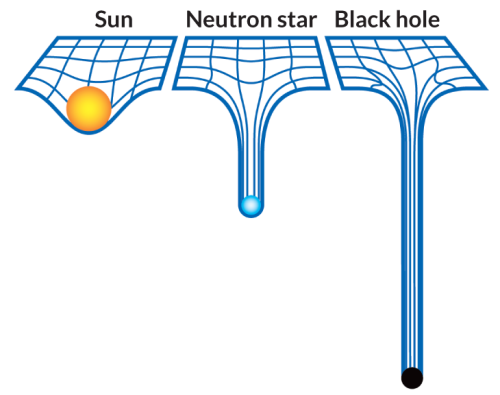
What are Gravitational Waves?
If you drop an object in a medium such as water, they produce ripples that propagate as waves through the medium.

Similarly, Gravitational waves are ripples in space-time fabric produced when you drag heavy objects through space time.
And the nature of these waves is that they don’t require a medium to propagate.
How do you make one?
Everything with mass/energy can create these waves.

Source
Two persons dancing around each other in space too can create gravitational waves. But the waves would be extremely faint.
You need something big and massive accelerating through space-time in order to even detect them.

And orbiting binary stars/black holes are valuable in this retrospect.
How can you detect them?
Let’s turn to the problem to detecting them assuming you do find binary stars/black-holes in the wondrous space to suite your needs.
Well, for starters you cannot use rocks/ rulers to measure them because as the space expands and contracts, so do the rocks. ( the distances will remain same in both the cases )

Here’s where the high school fact that the speed of Light is a constant no matter what plays an important and pivotal role.
If the space expands, the time taken for light to reach from A to B would be longer. And if it contracts, the time taken for it to reach from A to B would be smaller.

PC: PHDComics
By allowing the light waves from the contraction and expansion to interfere with each other, such as done in any interferometry experiment we can detect the expansion or contraction. Voila!
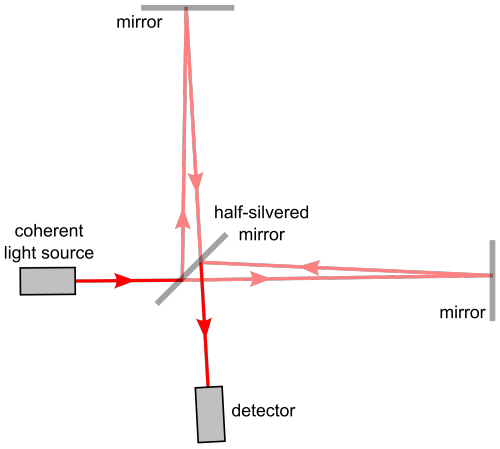
And this is exactly what they did! ( on a macroscopic level ) at LIGO (Laser Interferometer Gravitational-Wave Observatory)
14 September 2015

Two Black Holes with masses of 29 and 36 solar masses merged together some 1.3 Billion light years away.
Two Black Holes colliding is the header animation of the ‘Black Holes are not so Black Series’, in case if you haven’t noticed.

The merger of these two black holes results in the emission of energy equivalent to 3 solar masses as Gravitational Waves.
This signal was seen by both LIGO detectors, in Livingston and Hanford, with a time difference of 7 milliseconds.
And with the measurement of this time difference, physicists have pronounced the existence of Gravitational Waves.

Source
All this is most certainly easily said than done and requires meticulous and extensive research, not to mention highly sensitive instruments.
Had they not have measured this time difference, we might have had to wait for the merger for more massive black holes to collide and maybe even build more sensitive instruments to detect these waves.
And Einstein predicted this a 100 years back!

Mind Blown!
Note: Hope you are able to understand and appreciate the profundity of the discovery done by mankind.
** All animations used here are merely for Educational purposes. If you have any issues, please write to us at : 153armstrong@gmail.com










Pride and Prejudice by Jane Austen Illustrated by Charles E Brock with an introduction by Austin Dobson London Macmillan and Co Limited 1895 / 1901 452 pages + ads, all page edges gilt, measures 187mm x 130mm
An attractive copy of a classic illustrated edition in the publishers salmon coloured cloth with swirling art nouveau design covers










Staff Pick of the Week
As a lover of mythology and folklore, my first staff pick is The Wonder-Smith and His Son, by Ella Young (1867-1956), with illustrations by Boris Artzybasheff (1899-1965). It was published by Longmans, Green Co. in 1927 and was a Newbery Honor recipient in 1928. The book is a collection of myths from Ireland and Scotland about a legendary wonder smith known as the Gubbaun Saor, a “maker of worlds and a shaper of universes.” There are fourteen stories in the collection, detailing how the Gubbaun Saor got his world-building abilities, which involved finding a bag of magical tools that were dropped from the sky by a bird. The book also includes tales about his adopted son Lugh and his daughter Aunya. In her memoir, Flowering Dusk: Things Remembered Accurately and Inaccurately, Young wrote “I have a fondness for The Wonder-Smith; perhaps because I did not invent the stories in the book. I gathered them through twenty-five years of searching, and put a thread of prose round them.” The folktales were collected from story-tellers in Clare, Achill Island, Aranmore, and the Curraun.
Ella Young’s interest in Celtic mythology led to her becoming involved with the growing Irish nationalist movement. Many nationalist writers and artists were looking to Ireland’s history and legends for inspiration, and she befriended fellow Irish writers Æ (George William Russell), Padraic Colum, and William Butler Yeats. Æ called her “a druidess reincarnated.” Aside from publishing poetry and folklore, Yong was also involved in running guns and ammunition to the Irish Republican Army, and was a member of Cumann na mBAn, a women’s paramilitary organization that took part in the 1916 Easter Rising. She continued to write throughout the war, and in 1925 embarked for America to do a speaking tour about Celtic mythology at universities across the country. She was eventually granted American citizenship and accepted a teaching position at the University of California, Berkeley. Often described as mystical and otherworldly, Young lived out the rest of her life near the California coast writing and publishing stories and sharing her love of folklore with those around her.
Ukrainian illustrator Boris Artzybasheff fled the Russian Revolution for the United States in 1919. Beginning his career as an engraver, Artzybasheff soon became a book illustrator, some of which he wrote himself, such as Seven Simeons: A Russian Tale, which received a Caldecott Honor award in 1938. He is best known for his magazine covers, and he created over 200 covers for Time magazine alone. Over the course of his career his work evolved to become wonderfully surrealist, he loved anthropomorphizing machines so they would have human attributes and emotions. Even his commercial work in advertising has elements of the absurd. I believe Artzybasheff’s playfulness is evident in the woodcuts he did for The Wonder-Smith, and his illustrations are what drew me to the book.
– Sarah, Special Collections Undergraduate Assistant
Book Lovers Day - Free Aeronautics e-Books from NASA

Quieting the Boom

The Shaped Sonic Boom Demonstrator and the Quest for Quiet Supersonic Flight.
Download it HERE
Elegance in Flight

A comprehensive History of the F-16XL Experimental Prototype and its Role in our Flight Research.
Download it HERE
Probing the Sky

Selected National Advisory Committee for Aeronautics (NACA) Research Airplanes and Their Contributions to Flight.
Download it HERE
Cave of the Winds

The huge Langley Full-Scale Tunnel building dominated the skyline of Langley Air Force Base for 81 years (1930–2011). Explore how the results of critical tests conducted within its massive test section contributed to many of the Nation’s most important aeronautics and space programs.
Download it HERE
A New Twist in Flight Research

A New Twist in Flight Research describes the origins and design development of aeroelastic wing technology, its application to research aircraft, the flight-test program, and follow-on research and future applications.
Download it HERE
Sweeping Forward

Developing & Flight Testing the Grumman X-29A Forward Swept Wing Research Aircraft.
Download it HERE
Thinking Obliquely

Robert T. Jones, the Oblique Wing, our AD-1 Demonstrator, and its Legacy.
Download it HERE
The Apollo of Aeronautics

The fuel crisis of the 1970s threatened not only the airline industry but also the future of American prosperity itself. It also served as the genesis of technological ingenuity and innovation from a group of scientists and engineers at NASA, who initiated planning exercises to explore new fuel-saving technologies.
Download it HERE
X-15: Extending the Frontiers of Flight

X-15: Extending the Frontiers of Flight describes the genesis of the program, the design and construction of the aircraft, years of research flights and the experiments that flew aboard them.
Download it HERE
Ikhana

Delve into the story of the Ikhana, a remotely piloted vehicle used by NASA researchers to conduct Earth science research, which became an unexpected flying and imaging helper to emergency workers battling California wildfires.
Download it HERE
NASA’s Contributions to Aeronautics, Volume 1

This first volume in a two-volume set includes case studies and essays on NACA-NASA research for contributions such as high-speed wing design, the area rule, rotary-wing aerodynamics research, sonic boom mitigation, hypersonic design, computational fluid dynamics, electronic flight control and environmentally friendly aircraft technology.
Download it HERE
NASA’s Contributions to Aeronautics, Volume 2

Continue your journey into the world of NASA’s Contributions to Aeronautics with case studies and essays on NACA-NASA research for contributions including wind shear and lightning research, flight operations, human factors, wind tunnels, composite structures, general aviation aircraft safety, supersonic cruise aircraft research and atmospheric icing.
Download it HERE
Interested in other free e-books on topics from space, science, research and more? Discover the other e-books HERE.
Make sure to follow us on Tumblr for your regular dose of space: http://nasa.tumblr.com
Top 10 Most Uncomfortable Physics Facts
While physics can show us amazing things about our universe, it doesn’t always agree with how we think things should work. Sometimes, physics can be very counter-intuitive, and often unsettling. So, here’s my list of physics facts that can be a bit unnerving.
10: Weight doesn’t matter
If it wasn’t for air resistance, everything would fall at exactly the same speed. If you let go of a hammer and a feather from the same height at the same time on the Moon, they would hit the ground simultaneously.
9: Gyroscopic precession
It doesn’t matter how much you know about physics; gyroscopes are weird. The way they seem to defy gravity makes you rethink everything you know about physics, despite being fairly simple toys. Still, it’s all just Newton’s laws of motion.
8: Neutrinos and dark matter
We like to think that we can interact with most of the world around us, but this couldn’t be further from the truth. Neutrinos and dark matter are passing through your body right now, as if you weren’t even there. The fact that 65 billion neutrinos pass through each square centimeter of your body every second is weird enough, who knows what we’ll learn about dark matter.
7: Photons are particles
Light travels like a wave, but can only interact like a particle. It can interfere and have a frequency, but it can only take and give energy in discrete quantities. It behaves like nothing else in our macroscopic world, and can be very difficult to imagine.
6: Electrons are waves
We’ve established how photons act like waves and particles, but surely massive particles act normally. Nope! Even electrons have wave-like properties. In fact, everything acts like a wave! Except these waves come in discrete quantities, which we’ll call particles. This won’t get confusing.
5: E=mc^2
Einstein’s most famous contribution to physics states that matter is simply another form of energy, which has very profound consequences. A wound-up Jack-in-a-box would weigh ever so slightly more than a released Jack-in-a-box, due to the potential energy stored within.
4: Time is relative
The core of special relativity states that time passes differently for different observers. If you took a trip to Alpha Centauri at 99% the speed of light, everyone on Earth would see the trip take 4.4 years, while you would only experience 7.5 months. Time travel is real!
3: The (not so empty) vacuum
Something can be created from nothing, as long as it goes right back to being nothing quickly. In seemingly empty space, particles pop in and out of existence all the time as a result of the uncertainty principle. Not to mention, space is inflating at an accelerated rate due to “dark energy”. To the vacuum, the law of conservation of energy is more of a suggestion.
2: c is the fastest speed
Another important point in special relativity is that nothing could ever go faster than light. This doesn’t sit well with a lot of people, but the math doesn’t lie. To even get something with mass to travel at the speed of light would require infinite energy. Even if you somehow get around this, there are just too many mathematical problems with superluminal travel. Like it or not, the universe has a speed limit.
1: The cat is dead and alive
How could it not be this? The nature of quantum mechanics allows for objects to take on two seemingly contradictory states in a ‘superposition’. An electron can be in two places at once, or in a more extreme example, a cat can be both dead and alive. Of course, this weird property goes away once someone makes an observation. It’s as if there are tiny physics trolls messing with nature whenever we’re not looking.
Of course, there’s plenty more unsettling physics facts, like the space-bending nature of general relativity, or the “spooky action at a distance” that is quantum entanglement, but these are my top 10. I’d like to hear any unsettling physics facts you think I’ve missed, though!




Happy Birthday, @smokey-bear (August 9th)!
Everybody loves Smokey the Bear and truthfully what’s not to love? His message of conservation and environmental concern is even more relevant today than it was in 1944 when the campaign was created. In 1952 the Smokey the Bear song was written by Steve Nelson and Jack Rollins and became a grade school standard. Feel free to sing along: here are the lyrics from Living, Learning, Loving West Virginia from the Conservation Commission of West Virginia, 1958. Have fun and remember “Only you can prevent forest fires.”






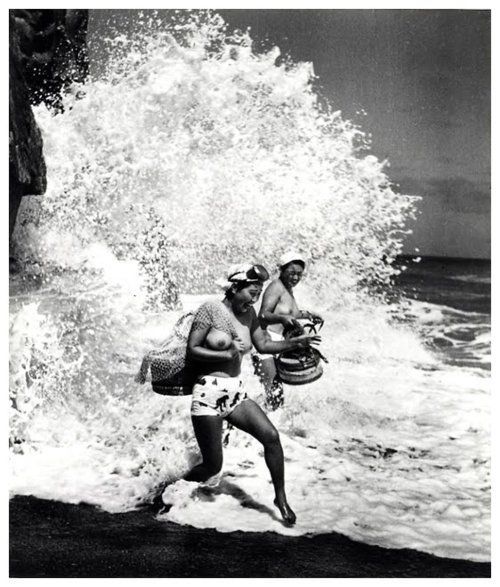

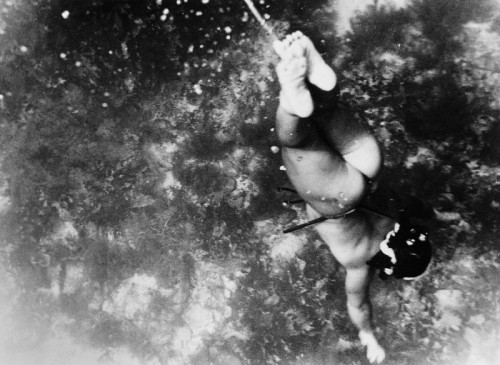
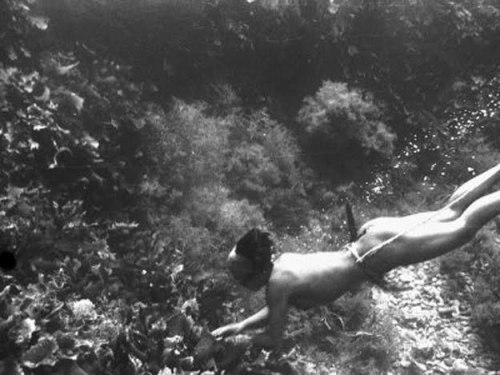
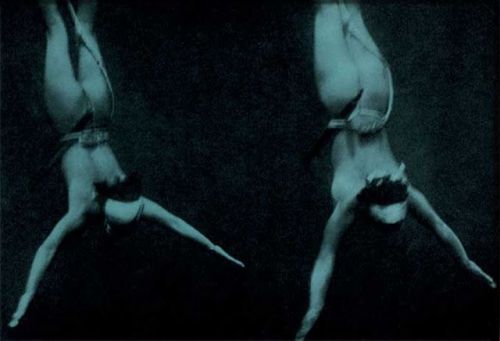
The Last Japanese Mermaids
For nearly two thousand years, Japanese women living in coastal fishing villages made a remarkable livelihood hunting the ocean for oysters and abalone, a sea snail that produces pearls. They are known as Ama. The few women left still make their living by filling their lungs with air and diving for long periods of time deep into the Pacific ocean, with nothing more than a mask and flippers.
In the mid 20th century, Iwase Yoshiyuki returned to the fishing village where he grew up and photographed these women when the unusual profession was still very much alive. After graduating from law school, Yoshiyuki had been given an early Kodak camera and found himself drawn to the ancient tradition of the ama divers in his hometown. His photographs are thought to be the only comprehensive documentation of the near-extinct tradition in existence
im putting together a couple of scottish folk mixes bc that’s what i do and im honestly curious if anyone in my country has ever been unequivocally happy about anything ever







#Feathursday: Innate and Learned Behaviors
Once again we bring you a portion of the educational series Man: A Course of Study. This booklet uses the Herring Gull to teach innate and learned behaviors. We wish we knew who the illustrator of this booklet was because they’ve done a great job helping us understand how baby bird brains work.
Man: A Course of Study was developed by Jerome S. Bruner, an American psychologist who wanted to build a curriculum to teach fifth graders about what it is to be human. He often used animals as contrast to help explain the biological nature of humans.
From the teaching series, Man: A Course of Study published by Curriculum Development Associates. Our copy is the first commercial edition published in 1970.
More Feathursday posts
Some of our other posts from Man: A Course of Study


Scroll of Esther, Venice, 18th century
This Venetian eighteenth century Scroll of Esther is enclosed within an elegant tubular scrolled filigree case. The cylindrical case of delicate silver filigree is beautifully decorated with floral motifs, with a gilded, flower-shaped element on top. In contrast to its richly ornamented case, the parchment scroll is very simple and has no decorations around the handwritten text.
U. Nahon Museum of Jewish Italian Art Gift of Mrs. Zaban in memory of her parents, who were murdered in Auschwitz. Trieste, 1987


In one of the most hostile regions known to humankind, conservationists unearthed an ice-covered fruitcake they believe once belonged to the British explorer Robert Falcon Scott, the New Zealand-based Antarctic Heritage Trust said this past week.
The age of the fruitcake: 106 years old.
A program manager said it was in “excellent condition.”
And the trust said it smelled “almost” edible.
The cake, dating to the Cape Adare-based Northern Party of Scott’s Terra Nova expedition (1910-13), was found in Antarctica’s oldest building, which was constructed by a Norwegian explorer’s team in 1899 and used by Scott’s team in 1911, the trust said.
(Read more at NYT)
I read once that shortly before The Merchant Of Venice was written, Queen Elizabeths doctor (who was Jewish) tried to poison her; is that true?
Sort of.
There was a doctor accused of trying to poison Queen Elizabeth. His name was Roderigo Lopez. He was Jewish and of Spanish descent and was fairly well off. He was accused of trying to poison her and conspiring against her with Spanish officials. I believe he is the only English physician to have been executed.
HOWEVER, we don’t know if he actually wanted to poison her. There was no attempt I believe, just accusations. He stated before he died that he “loved the Queen as much as he loved Jesus Christ” which can (and was) be interpreted in many ways. Some people think the Queen thought he was innocent because she took a long time to sign his death warrant. The character may have been the inspiration for Shylock in the Merchant of Venice, since they are both considered villains and evil because they’re Jewish but no one is 100% sure. Based on what I’ve heard, I don’t think he actually wanted to poison the queen and was probably just a target of antisemitism and maybe anti Spanish sentiment but who knows.
Thanks for bringing this up! I’m sure people would love to read about it. I’ve put the Wikipedia article below:
https://en.wikipedia.org/wiki/Roderigo_Lopez#Royal_physician
-Admin @thesunofyork



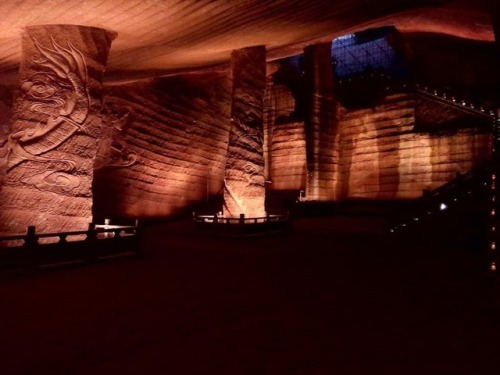
In 1992, a man named Wu Anai, near a Chinese village in Longyou County, based on a hunch, began to pump water out of a pond in his village. Anai believed the pond was not natural, nor was it infinitely deep as the local lore went, and he decided to prove it. He convinced some of his villagers and together they bought a water pump and began to siphon water out of the pond. After 17 days of pumping, the water level fell enough to reveal the flooded entrance to an ancient, man-made cave!
The cave has twenty-four rooms. There are pillars, staircases, and high ceilings over 30 meters (98 ft!) up. The work was done by humans, we know, because they left visible chisel marks in uniform bands of parallel groves. With over 30,000 square meters of space, all meticulously chiseled, this would have been a huge undertaking. Even if people were simply enlarging caves which already existed, it would still have required a lot of manpower working in a coordinated system for a long period of time.
Since the project would have been so large, it seems amazing that no record of it exists in China’s extensive written history. But there is not a word. Based on the cave alone, it is estimated to have been completed around 200 BCE, near the Qin Dynasty or Han Dynasties.





















